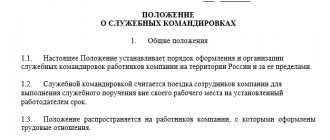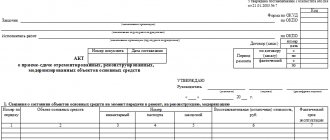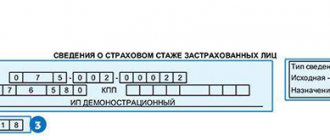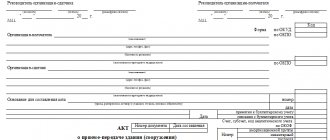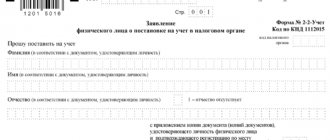Statistical reporting of an organization: how to correctly fill out Form 11 of statistical reporting, whether it is necessary to reflect leased land plots in Form 11 - read the article.
Question:
1) Is it necessary to indicate land plots in Form No. 11 (transaction), because land plots do not have an OKOF code and depreciation is not charged on them? The land plots are leased from us (we are tenants). 2) And how to correctly fill out column 12 of the same form if the residual value of the fixed asset is 0 (this does not apply to land plots)?
Answer:
Statistical reporting of Form 11 (transaction) takes into account objects that are leased, and at the same time are on the balance sheet of the reporting organization in the accounts for accounting for fixed assets, namely, leased during the reporting year, which, in accordance with the financial lease agreement, are accounted for by the lessee in the account on accounting of fixed assets. As a general rule, a land plot is recognized as an object of fixed assets. Therefore, if, under the terms of the lease agreement, this land plot is listed on your balance sheet (account 01), then information about it must be indicated in this report. Otherwise, if you account for a land plot off-balance sheet in off-balance sheet account 001, then information about such objects is not indicated in the report. Column 12 of Section 2 is filled out similarly to Column 13 of Section I. Therefore, by analogy with Column 13 (according to the instructions), Column 12 of Section 2 indicates an estimate of the full number of years of the estimated actual remaining service life of this object, from the end of the reporting year until the expected moment of its liquidation, which is determined expertly (taking into account the opinion of a technical specialist), based on the feasibility of using the object. At the same time, we draw your attention to the fact that this reporting form has become invalid starting from the reporting for 2014. Therefore, you may need to fill out a different stat form. reporting, which is completed according to other parameters.
Alexander Sorokin answers,
Deputy Head of the Operational Control Department of the Federal Tax Service of Russia
“Cash payment systems should be used only in cases where the seller provides the buyer, including its employees, with a deferment or installment plan for payment for its goods, work, and services. It is these cases, according to the Federal Tax Service, that relate to the provision and repayment of a loan to pay for goods, work, and services. If an organization issues a cash loan, receives a repayment of such a loan, or itself receives and repays a loan, do not use the cash register. When exactly you need to punch a check, see the recommendations."
The rationale for this position is given below in the materials of the Glavbukh System
Legal basis:
Order of Rosstat 07/03/2013 No. 258
On approval of statistical tools for organizing federal statistical monitoring of the availability and movement of fixed assets (funds) and other non-financial assets (as amended as of April 1, 2014)
(lost force from the 2014 report to based on Rosstat order No. 543 dated August 29, 2014)
2. In Section I... In Column 13 for the acquired object, an estimate of the total number of years of the expected actual remaining service life of this object is indicated, from the end of the reporting year to the expected moment of its liquidation, which is determined expertly (with taking into account the opinion of a technical specialist), based on the feasibility of using the object.* If the object is liquidated - or is expected to be liquidated - in the year following the reporting year, then “1” is entered in column 13. This column does not provide the planned service life of the object, determined on the basis of depreciation rates for accounting or tax accounting. Filling out this column for purchased objects is mandatory.
3. Section II takes into account objects leased as of the end of 2013 (regardless of whether they were leased during 2013 or before the beginning of this year), and at the same time standing on the balance sheet of the reporting organization, in the accounts of accounting of fixed assets and profitable investments in material assets: - leased during the reporting year, which, in accordance with the financial lease agreement, are accounted for by the tenant (lessee) in the account for accounting of fixed assets; * - leased during the reporting year, presented to the tenant (lessee ) for temporary paid possession and use, recorded by the lessor (lessor) in the account for accounting of fixed assets or profitable investments in material assets: for large businesses - up to 10 separately accounted objects or their sets; for medium-sized businesses - up to 7; for small businesses - up to 5, for non-profit organizations - up to 5 objects.
By Order of Rosstat dated July 4, 2019 No. 382, new forms of statistical reporting were introduced, starting with reporting for 2021. The order contains the following forms:
- form 11;
- Form 11 (short);
- Form 11 (transaction).
Instructions for filling out these forms were approved by Rosstat Order No. 717 dated November 29, 2019 (hereinafter referred to as the Instructions).
Forms 11 have undergone the following changes:
- In the full version, new columns appeared in Section 1 and the report structure was slightly changed (new sections were highlighted and added).
- In the summary section 1, new columns have appeared and information has been regrouped into sections.
- Form 11 (Transaction) has added or deleted some columns. The list of respondents has been clarified: now there is no need to submit a report not only to micro, but also to all small enterprises.
Deadlines for submitting annexes to Form 11 for 2021
Submission of Form 11-statistics (general) is mandatory for all companies except non-profit organizations, small and micro enterprises. If the company does not have indicators for the reporting year, then it must still submit a form with zero values or send a letter explaining the lack of activity to the territorial bodies of Rosstat.
The deadlines for submitting Form 11-statistics (both full and short) are established by Rosstat order No. 382 dated July 4, 2019. The deadline for submitting the report is April 1 of the next year. The form is annual, that is, submitted once a year. Those who do not submit the form before this deadline will face sanctions provided for in Art. 13.19 Code of Administrative Offenses of the Russian Federation.
The application to Form 11-statistics (transaction) is submitted before June 30 of the year following the reporting year. Form 11 (transaction) provides information on sales made on the secondary market and on all transactions for the lease of fixed assets (hereinafter referred to as FFA) performed by the respondents.
Features of submitting forms 11 for different enterprises
The list of legal entities whose responsibilities include filling out form 11-statistics is presented in the instructions for each form.
So, Form 11 is submitted, as mentioned above, by all legal entities (except NPOs and SE), including those who have chosen the simplified taxation system. Unitary and state-owned enterprises, if they are granted the right of economic management or operational management of the PF, report in Form 11 (short). In addition, consumer cooperation organizations whose main activities are costly in nature (for example, gardening, country, housing, housing-construction cooperatives) report in a short form.
If an enterprise is declared bankrupt and bankruptcy proceedings are underway against it, it is obliged to submit statistical reports in Form 11 until an entry about its liquidation is made in the Unified State Register of Legal Entities.
If the enterprise is newly created, then it fills in the data that appeared during the period of its management during the reporting year. At the same time, it should show the absence of PF at the beginning of the year. The same rule applies to companies that have undergone reorganization, in terms of reporting for part of the year after completion of this procedure.
Filing reports of enterprises with separate divisions
Reporting is submitted to the local regional office of Rosstat at the company's location. If a legal entity has branches located in other subjects of the Federation, forms are filled out for each of them, including the parent company separately, and submitted to the regional branches at their location. Also, separate reporting is submitted for PFs located in other regions, in a manner similar to branches.
If an enterprise has branches located in the same subject of the Federation as the head office, how to fill out Form 11 in statistics? Sections I-IV are filled out as a whole for the parent company and branches, but section V is filled out for each of them separately, on a new sheet.
Moreover, if separate subdivisions are located at the same postal address or at different, but close to each other within the same municipal/urban district, the report is filled out as for one separate subdivision.
Don't know your rights?
Objects reflected in reporting
According to paragraph 3 of the Guidelines, respondents must be guided by the principles of accounting for fixed assets (FA). At the same time, in order to classify OS in Form 11, it is necessary to use the classifier approved by Rosstandart order No. 2018-st dated December 12, 2014 and put into effect in 2021 with amendments approved by Rosstandart order No. 1746-st dated November 10, 2015.
In Form 11 it is necessary to enter information about the assets reflected in the balance sheet:
- fixed assets (buildings, equipment, machinery, construction in progress in the part that relates to objects intended for their own use, or paid for by clients);
- investments of the organization in material assets provided for use to generate income;
- exploration assets in tangible and intangible form;
- Intangible assets that are legally protected from misuse, as well as those that are received for use and accounted for in an off-balance sheet account;
- R&D expenses.
The reporting does not reflect:
- land plots, water, subsoil and other environmental management facilities, since for the purposes of statistical research they are classified as non-productive assets;
- non-productive intangible assets;
- PF costing less than 20,000 rubles. for a unit.
PF are reflected in the report at the initial and residual book value (clause 6 of the Guidelines).
Information about which assets should be displayed in Form 11
The report includes data on the following PF (fixed assets):
- Buildings, machines, equipment.
- Construction in progress.
- Assets related to intellectual property.
- Research and development results.
- Profitable investments in material assets.
- Intangible search assets.
- Intangible assets received for use related to intellectual property.
The document does not include information about the following assets:
- fixed assets, the cost of which is less than 20 thousand rubles. (for OS, the commissioning of which was before 01/01/2011) or 40 thousand rubles. per unit (fixed assets put into operation after 01/01/2011), if they are not listed as fixed assets in accounting;
- non-produced intangible assets (licenses, lease agreements, etc.);
- land plots and other environmental management facilities.
How to fill out the application to form 11-statistics
Form 11 (general) consists of the following sheets:
- title (you should indicate the year for which the report is being submitted, the name and OKPO code of the respondent (or the identification number of a separate division));
- section I (the tabular form is entered to reflect the availability and cost dynamics of each of the enterprise’s PF objects);
- section II (information is recorded on the availability and movement of PF by type of economic activity);
- section III (data on the presence and average age of PF is reflected);
- section IV (responsible for information about PF that are not subject to depreciation);
- section V (reflects the average annual total accounting value of the organization's PF).
Section 5 (OS by territorial divisions)
Section 5 of Form 11 reflects data on fixed assets at the disposal of separate divisions of the reporting company, which are located in the same subject of the Russian Federation with the head office. Fixed:
- OKPO;
- data on the average annual full accounting value of fixed assets in the division.
Fill out as many copies of Section 5 sheets as there are divisions of the reporting company, including those that do not have OS.
You can download a sample of filling out Form 11 in ConsultantPlus. To do this, you need to sign up for trial demo access to the K+ system. It's free.
How to fill out short form 11 in statistics
Like the general form, short form 11 for statistics in 2021 is also filled out in accordance with Rosstat order No. 382 dated July 4, 2019. The short form consists of the following sheets:
- title (indicate the reporting year, name and OKPO of the respondent);
- section I (table in which information on the availability and movement for the year is filled out in the context of individual PF objects);
- Section II (clarification of Section I by type of economic activity);
- section III (presence and average age of PF);
- Section IV (average annual total accounting value of the organization's PF)
As you can see, short form 11 differs from general form 11 in the absence of a section on PF, which are not subject to depreciation.
In order for Rosstat to be able to analyze all the data on fixed assets and other non-financial assets used by enterprises, respondents must submit reports in Form 11. This reporting is mandatory for almost all enterprises, regardless of the form of ownership and type of activity in which they are engaged. Enterprises face a fine for failure to submit reports.
One of the forms that respondents must submit to the statistical authorities is Form 11 (Transaction). The form can be found in Appendix No. 3 to Rosstat Order No. 289 dated June 15, 2016. Form 11 (transaction) reflects annual information on transactions with fixed assets on the secondary market and their rental. Rosstat needs this information to calculate the current market value of fixed assets.
Filling out Form 11 (transaction)
When filling out Form 11 (transaction), there are several points to consider:
- If the organization has separate divisions, the data is presented as a whole for the organization (taking into account the EP data);
- To fill out Form 11 (transaction) for 2021, the old OKOF is used - OK 013-94 (approved by Resolution of the State Standard of the Russian Federation dated December 26, 1994 N 359);
- The form does not reflect unfinished assets;
- Certain control ratios must be observed. These control ratios, as well as detailed instructions for filling out Form 11 (transaction), can be found in the Instructions for filling out the form, approved. By Order of Rosstat dated June 15, 2016 No. 289
Why do we need a form?
The report is submitted to summarize information on the availability and structure of fixed assets used in the activities of the enterprise.
The form and instructions for filling out Form 11 (statistics) 2021 were developed by Rosstat order No. 384 dated July 15, 2020. The size of non-current assets is one of the key indicators that are of interest to investors and other persons interested in receiving income from the company’s activities. Government authorities request such information to assess the risk of uncollectible debt to creditors and the budget in cases of bankruptcy. In contrast to the balance sheet data, Form 11 (statistics) on fixed assets contains detailed information about the structure, value and age of the company’s non-current assets.
Form 11 (transaction): submission deadline
This form is submitted once a year - no later than June 15 of the year following the reporting year. Form 11 (Transaction) for 2021 must be submitted no later than 06/15/2017.
Keep in mind that for violating the deadline for submitting statistical reports, as well as for failing to submit them at all, the respondent faces a fine (
July 03
Order of Rosstat dated June 26, 2017 N 428
“On approval of statistical tools for organizing federal statistical monitoring of the availability and movement of fixed assets (funds) and other non-financial assets”
New annual forms for statistical monitoring of the availability and movement of fixed assets (funds) and other non-financial assets have been approved (forms N 11, N 11 (short), N 11 (transaction), N 11-NA), effective from the 2021 report.
Form No. 11 “Information on the availability and movement of fixed assets (funds) and other non-financial assets” is submitted to Rosstat by legal entities (except for small businesses and non-profit organizations) engaged in all types of economic activities. The deadline for submission is April 1.
Form No. 11 (short) “Information on the availability and movement of fixed assets (funds) of non-profit organizations” is submitted to Rosstat by legal entities - non-profit organizations engaged in all types of economic activities. The deadline for submission is April 1.
Form No. 11 (transaction) “Information on transactions with fixed assets on the secondary market and their rental” is submitted to Rosstat by legal entities (except micro-enterprises) engaged in all types of economic activities. The deadline for submission is June 15.
Form N 11-NA “Information on the availability, movement and composition of contracts, leases, licenses, marketing assets and goodwill (business reputation of the organization)” is submitted to Rosstat by legal entities (except for small businesses) engaged in all types of economic activities. The deadline for submission is June 30.
Instructions for filling out these forms have also been approved. It is possible to submit forms electronically.
With the introduction of new forms, Rosstat Orders No. 296 dated July 3, 2015 and No. 289 dated June 15, 2016, which approved the previously valid forms, are declared invalid.
The review was prepared by specialists and provided by the information center of the ConsultantPlus Network in Yekaterinburg and the Sverdlovsk region
The form can be found in Appendix No. 3 to Rosstat Order No. 289 dated June 15, 2016. Form 11 (transaction) reflects annual information on transactions with fixed assets on the secondary market and their rental. Rosstat needs this information to calculate the current market value of fixed assets. Form 11 (transaction): you can download this form on the Rosstat website or in the ConsultantPlus system. Form 11 (transaction): those who submit Form 11 (transaction) must represent all organizations (except micro-enterprises) that had in the reporting year:
- fixed assets;
- profitable investments in material assets;
- intangible fixed assets, the rights to which are obtained on the basis of a non-exclusive/exclusive license;
- produced tangible and intangible exploration assets.
Form 11 (transaction): composition The form consists of a title page and three sections.
Statistical forms for fixed assets: what has changed?
All state (municipal) institutions, including medical institutions, compile and submit to territorial statistical bodies information on the availability and movement of fixed assets. On January 1, 2021, the FSBU “Fixed Assets” came into force, which introduced new concepts and new rules in accounting for fixed assets. This made it necessary to adjust the statistical forms used for reporting on these objects. In this regard, Rosstat issued Order No. 449 dated July 19, 2018 (hereinafter referred to as Order No. 449), which approved new reporting forms. We will talk about them further.
Order No. 449 approved the following forms of federal statistical observation:
1) annual starting from the 2021 report
:
– 11 “Information on the availability and movement of fixed assets (funds) and other non-financial assets” (the form and instructions for filling it out are given in Appendix 1 to Order No. 449); – 11 (short) “Information on the availability and movement of fixed assets (funds) of non-profit organizations” (the form and instructions for filling it out are given in Appendix 2); – 11 (transaction) “Information on transactions with fixed assets on the secondary market and their rental” (the form and instructions for filling it out are given in Appendix 3);
2) one-time for the 2021 report
– 11-FSS “Information on the service life of fixed assets” (the form and instructions for filling it out are given in Appendix 4).
We invite you to familiarize yourself with the features of filling out each of these forms.
Form 11 “Information on the availability and movement of fixed assets (funds) and other non-financial assets”
Non-profit organizations, which include state medical institutions, do not fill out this statistical form ( clause 3 of article 50 of the Civil Code of the Russian Federation
,
paragraph 1
instructions for filling out the form). Instead, healthcare institutions compile and submit to statistical authorities information on the availability and movement of fixed assets (funds) of non-profit organizations (form 11 (short)). It is worth noting that form 11 as amended by Order No. 449 looks almost the same as before, only in section 1 “Availability, movement and composition of fixed assets” the names of the lines that reflect the presence and movement of the following accounting objects have changed:
– machines, equipment and vehicles (lines 5 – 8); – cultivated biological resources that repeatedly produce products (lines 9 – 12).
Otherwise the form remains the same.
Form 11 (short) “Information on the availability and movement of fixed assets (funds) of non-profit organizations”
Comparing Form 11 (short), approved by Order No. 449, with a similar form filled out by institutions at the end of 2021, we came to the conclusion that it has not changed much. As with the previous form, it contains:
– the detailing of the lines in the “Machinery, equipment and vehicles” group has been changed (lines 5 – 8); – added lines reflecting the presence and movement of objects belonging to the group “Cultivated biological resources that repeatedly produce products.” Previously, Form 11 (short) did not contain these lines, since until January 1, 2021, the accounts used to account for this group of assets were in instructions No. 157n
,
No. 162n
,
No. 174n
,
No. 183n
were missing.
Otherwise, the procedure for filling out the form remains the same.
Form 11 (transaction) “Information on transactions with fixed assets on the secondary market and their rental”
This statistical form for healthcare institutions is also not new; they filled it out at the end of 2021. The form is submitted by legal entities, including small (without micro-enterprises) and medium-sized businesses and non-profit organizations of all types of economic activity, having fixed assets in accounts for accounting for fixed assets and profitable investments in material assets. Incomplete assets and items related to intellectual property are not reflected in the form. The form is submitted to the territorial bodies of state statistics only if there is an observed event:
– sale and acquisition of used material fixed assets in the reporting year; – availability of leased and leased objects in the reporting year.
For your information:
in the absence of such events, Form 11 (transaction) is not submitted to the territorial statistical authorities.
By Order No. 449 the following amendments were made to this form:
1. In Section 1 “Used objects of material fixed assets sold and acquired in the reporting year”:
a) added column 11 “Object area, sq. m." – to be completed in relation to buildings and structures. (Recall that this section reflects information regarding the sale and acquisition in the reporting period of each separate building, a separate structure with all the devices that form a single whole with it, a separate machine, etc. The sale and acquisition of new objects produced has not yet serving as fixed assets, as well as the gratuitous transfer and acquisition of fixed assets, their sale and acquisition not at market prices, as well as the transfer or sale of objects for the purpose of their disposal (equipment for scrap metal, buildings and structures for construction materials, etc. ) are not taken into account in the section.);
b) the names of some lines have been changed:
– line 8 reflects information regarding information, computer and telecommunications equipment; – line 2 reflects information regarding objects of the group “Other machinery and equipment, including household equipment, and other objects.”
2. In section 2 “Fixed assets taken and leased” in column 13, when completed at the end of 2021, the area of the property is reflected in square meters (indicated for residential and non-residential buildings). Previously, this column indicated a code identifying the party bearing operating costs in relation to leased and leased facilities.
3. Section 3 “Transactions with intangible fixed assets completed in the reporting year” has been deleted.
Otherwise, the procedure for filling out the form remains the same.
Form 11-FSS “Information on the service life of fixed assets”
This is a new statistical form. It is filled out by legal entities (except for small enterprises, including microenterprises) of all types of economic activities that have actually carried out or are planning to liquidate fixed assets over the past three years, and submit them to the territorial body of Rosstat on June 25 of the year following the reporting year. The purpose of the survey is to obtain information about the actual service life of fixed assets, as well as information about their value according to primary accounting data (according to the data reflected in the inventory cards for accounting for non-financial assets (f. 0504031)).
Form 11-FSS is submitted to territorial state statistics bodies only if there is an observed event. If there is no event, it does not need to be presented.
The data is reflected for the legal entity as a whole, taking into account data for all its separate divisions and assets located in other constituent entities of the Russian Federation.
For your information:
A separate division of an organization means any territorially separate division from it, at the location of which stationary workplaces are equipped.
A separate division of an organization is recognized as such, regardless of whether its creation is reflected or not reflected in the constituent or other organizational and administrative documents of the organization, and regardless of the powers vested in the specified division. In this case, a workplace is considered stationary if it is created for a period of more than one month ( clause 2 of article 11 of the Tax Code of the Russian Federation
).
The form is also filled out by branches, representative offices and divisions of foreign organizations operating on the territory of the Russian Federation in the manner established for legal entities.
When filling out the form, you must use statistical observation form 11 (short) “Information on the availability and movement of fixed assets (funds) of non-profit organizations.”
Form 11-FSS takes into account information on non-residential buildings, residential buildings, structures, information, computer and telecommunications (ICT) equipment, other machinery and equipment, vehicles, as well as intellectual property objects - scientific research and development, subsoil exploration and evaluation mineral reserves, including produced exploration assets, software and databases. Reflection in the reporting form is subject to objects that were actually liquidated during 2021, 2021 and 2021 or sold for the purpose of physical liquidation by disassembly, disposal, etc., as well as objects intended for liquidation, that is, not yet physically liquidated, but already not used in the economic activities of the organization.
In column 1
the name of the object is indicated in accordance with the primary accounting data. In the event that objects of the same type are liquidated, having the same OKOF code and put into operation in the same year, the data on such objects is summarized.
In column 2
the code according to OKOF, put into effect
by Order of Rosstandart dated December 12, 2014 No. 2018-st, is indicated
(7 - 12 characters, including 3 characters written on the form), in accordance with the accepted code structure. An object encoded with an OKOF grouping code that includes less than 7 characters must be detailed to 7 characters or more, up to 12. If the names of some fixed assets are not in OKOF, then these objects are accounted for by OKOF codes that correspond as closely as possible to their intended purpose and characteristics of the objects available at OKOF. The use of other classifications is not permitted.
In column 3
the number of the depreciation group is indicated (from 1 to 10 inclusive) in accordance with
Decree of the Government of the Russian Federation dated January 1, 2002 No. 1 “On the Classification of fixed assets included in depreciation groups”
(with subsequent amendments).
In column 4
the year of initial commissioning of the fixed asset object is reflected on the basis of column 5 of section 1 of the inventory card for accounting for non-financial assets (form 0504031).
In column 5
The year of commencement of operation of the object in the organization is reflected, that is, the year the fixed asset object was accepted for accounting. The data in column 5 may differ from the data in column 4 (in the case when an object of fixed assets is accepted for accounting not new, that is, previously used by another organization) by the amount of the actual service life as of the date the object was accepted for accounting in the organization (column 6 of section 1 inventory card for accounting for non-financial assets (f. 0504031)).
In column 6
the actual age of the object (full number of years) at the time of its liquidation is indicated. For fixed assets intended for liquidation, the actual age as of the end of 2021 is indicated.
In column 7
the value of the year of actual liquidation of an object of fixed assets is reflected, which can be equal to 2021, 2021 or 2021. For objects of fixed assets intended for liquidation, but not physically liquidated, the value of the year of actual liquidation will be equal to 2018.
In column 8
the residual book value of the liquidated object is indicated, in
column 9
- the accumulated depreciation on the fixed assets object as of the end of the year of actual liquidation.
The residual book value reflects the change in the state of fixed assets, the gradual loss of their consumer properties and value during operation, under the influence of natural forces and due to technical progress in the amount of accumulated depreciation, taking into account their changes as a result of revaluation. In this case, the amount of depreciation is determined in accordance with the norms and methods of calculating such depreciation used in accounting. For fixed assets intended for liquidation, the residual book value and accumulated depreciation as of the end of 2021 are indicated.
In column 10
the year is indicated (from 1995 to 2021 inclusive), the prices of which take into account a specific object of fixed assets as of the end of the year of actual liquidation of the object of fixed assets. At the same time, for fixed assets, both included in prices on January 1 of a certain year, and included in the actual purchase prices of the same year, the same year is indicated. The year must be indicated in full (4 characters).
In column 11
the reason for the liquidation of the fixed assets object is reflected. It must contain one of the codes:
– 1 – unsuitability for further use due to unsatisfactory technical condition or physical wear and tear; – 2 – economic inefficiency of use due to obsolescence; – 3 – liquidation due to accidental damage, breakdown; – 4 – liquidation due to large-scale accidents, natural disasters or catastrophes.
In columns and lines, “0” is entered only in cases where the parameters of any indicator are zero; in the absence of information on the indicator, “–” (a dash) should be entered.
When filling out the form, the following mandatory control ratios are observed for all lines:
– columns 4 – 7, 9 – 11 > 0; – column 5 ≥ column 4; – column 7 > column 5; – column 10 ≥ column 5; – column 8 ≥ 0; – column 7 = 2016, or 2021, or 2018; – column 3 = 1, or 2, or 3, or 4, or 5, or 6, or 7, or 8, or 9, or 10; – column 11 = 1, or 2, or 3, or 4.
Also, when filling out the form, you need to consider the following points:
– if column 2 contains the OKOF code starting with 210, then column 3 = 4, or 5, or 7, or 8, or 9, or 10; – if column 2 contains the OKOF code starting with 100, then column 3 = 6 or 10; – if column 2 contains the OKOF code starting with 220, then column 3 = 3, or 4, or 5, or 6, or 7, or 8, or 9, or 10; – if column 2 contains the OKOF code starting with 320, then column 3 = 1, or 3, or 4, or 5, or 6, or 7, or 8, or 10; – if column 2 contains the OKOF code starting with 310, then column 3 = 3, or 4, or 5, or 6, or 7, or 8, or 9, or 10; – if column 2 contains the OKOF code starting with 330, then column 3 = 1, or 2, or 3, or 4, or 5, or 6, or 7, or 8, or 9, or 10.
Example.
The medical institution has a car on its balance sheet, which, due to the impossibility of further operation, was written off from the accounting accounts in December 2021. The car was handed over for recycling in January 2021. The inventory card for accounting for non-financial assets (f. 0504031) reflects the following information:
– OKOF code – 310.29.10.2; – year of commencement of operation by the institution – 2010; – depreciation group – 3; – actual age of the car – 15 years; – residual value of the object – 0 rub.; – the amount of accumulated depreciation is 380,000 rubles.
Based on the available data, Form 11-FSS in relation to the liquidated vehicle will be filled out as follows:
| Line number | Line name | Index |
| 1 | Name of fixed assets object | Automobile |
| 2 | Code OKOF | 310.29.10.2 |
| 3 | Depreciation group number | 3 |
| 4 | Year of initial commissioning | 2002 |
| 5 | Year of commencement of operation (acceptance) in the organization | 2010 |
| 6 | Age at time of liquidation (years) | 16 |
| 7 | Year of actual liquidation of the facility | 2018 |
| 8 | Residual book value of the asset at the time of liquidation | 0 |
| 9 | Accumulated depreciation at the time of liquidation | 380 000 |
| 10 | The year in which prices the fixed assets item is taken into account | – |
| 11 | Liquidation reason code | 1 |
* * *
In conclusion, we note that there have been no major changes in the structure of forms 11, 11 (short), 11 (transaction).
New is Form 11-FSS “Information on the service life of fixed assets”. It reflects information regarding fixed assets that were actually liquidated during 2021, 2021 and 2018 or sold for the purpose of physical liquidation through disassembly, disposal, etc., as well as objects intended for liquidation, that is, not yet physically liquidated , but are no longer used in the economic activities of the organization.
T. Obukhova expert of the information and reference system “Ayudar Info”
Procedure and sample for filling out statistics form No. 11
Fixed:
- name, address of the unit, its OKTMO, OKPO codes, main OKVED codes;
- data on the average annual full accounting value of fixed assets in the division.
As many copies of Section 4 sheets are filled out as there are divisions of the reporting company, including those that do not have OS. You can download a sample of filling out Form 11 on our website. What is form statistics 11 (transaction) Along with form 11, according to which firms submit to Rosstat information on the availability and movement of all fixed assets and non-current assets during the reporting year, there is form 11 (transaction), through which organizations inform the department about transactions with OS on the secondary market, as well as on the rental of the corresponding OS. For information on how accounting is organized for the tenant and the lessor, read the article “Accounting for the lease of fixed assets (nuances).”
Features of filling out the form by organizations that have separate divisions
An organization that has separate divisions submits Form 11 (transaction) taking into account the data on these divisions. That is, the form reflects the objects of both the parent organization and its separate divisions.
Russian representative offices and branches of foreign companies report on Form 11 (transaction) independently.
You no longer need to waste time searching for the required up-to-date form. Fill out the necessary reports to Rosstat in the Kontur.Extern system. Using the search, select statistics form 11 (transaction), enter the necessary information and save. Before submitting the completed form, the system will check it for errors. If there are any inconsistencies, you will see a warning. Once the issues are resolved, you can send a report. If the outcome is positive, an acceptance notification will appear in the system. If the report is not accepted, you will learn about this from the notification. You can also upload a ready-made document to Extern and send it to Rosstat. When submitting reports via Extern, you save time.
Form 11 (transaction)
Section I reflects information on used tangible fixed assets sold and purchased in the reporting year on the secondary market. Section II provides information on fixed assets leased and leased.
Section III reflects transactions with intangible fixed assets completed in the reporting year. Filling out form 11 (transaction) When filling out form 11 (transaction), you need to consider several points:
- If the organization has separate divisions, the data is presented as a whole for the organization (taking into account the EP data);
- To fill out Form 11 (transaction) for 2021, the old OKOF is used - OK 013-94 (approved by Resolution of the State Standard of the Russian Federation dated December 26, 1994 N 359);
- The form does not reflect unfinished assets;
- Certain control ratios must be observed.
How to send a report to the statistical authorities
The report is submitted in paper form in person or by a valuable letter with a list of attachments. But most organizations use an electronic format, which has several advantages:
- speed of data transfer;
- timely notification of possible errors;
- automatic checking of control ratios.
Independent verification of control ratios for Form 11 (statistics) is carried out according to the table given in paragraph 10 of Order No. 384. In particular, in section I, the value on page 01 is equal to the sum of lines 02, 04, 05, 09, 13 and 14. And the value in gr. 11 is the difference between columns 9 and 10.
Statistics: form 11. brief instructions for filling out
No later than 04/03/2017, organizations (except for small businesses and non-profit organizations) must submit to the territorial body of Rosstat for 2021 “Information on the availability and movement of fixed assets (funds) and other non-financial assets” (form No. 11). We will tell you how to fill out this form in our consultation. Filling out form 11 in statistics Form No. 11 was approved by Rosstat Order No. 289 dated June 15, 2016. You can download the form to fill out in Excel here. Form No. 11 consists of a title page and four sections:
- I “Availability, movement and composition of fixed assets”;
- II “Availability of fixed assets”;
- III “Fixed assets that are not subject to depreciation”;
- IV “Information on territorially isolated units.”
Instructions for filling out form No. 11 were approved by Rosstat Order No. 563 dated November 24, 2015.
How to fill out the reporting form form 11
Form 11 is a statistical report in which legal entities and their territorial divisions display information about fixed assets and other non-financial assets (their availability and movement).
Unlike Form 11 (short), it is intended for commercial organizations. The statistics report for 2021 must be completed on an updated form. It was approved by Rosstat order dated July 19, 2018 (as amended on August 31, 2018) No. 449.
All legal entities, including those who work on a simplified basis, are required to submit this report to Rosstat. The type of economic activity, type of ownership and legal form do not matter. The only exceptions are small businesses and non-profit organizations - they do not need to submit this report, non-profits submit their report - 11 (short).
Form 11 (transaction) and instructions for filling out the form
- the amount of accumulated expenses associated with the transfer of ownership of assets that are classified as non-produced (line 40);
- the cost of costs for work in progress equipment and vehicles intended for internal use (line 41);
- the cost of equipment to be installed in the company (line 42);
- the amount of costs related to the unfinished construction of real estate for internal use (line 43).
Below the table in section 2 the following data is also provided:
- on the amount of capital investments for land improvement (line 44);
- the amount of expenses for the transfer of ownership rights to assets classified as non-produced (line 45).
Section 3 (FA without depreciation) This section is also presented in a table.
Registration
In addition to its purpose and structure, Form 11 (transaction) differs from Form 11 in that:
- it must be submitted to Rosstat by all legal entities not related to microenterprises (including small and medium-sized enterprises and non-profit organizations);
- it must be submitted on a different date - before June 15 of the year following the reporting year.
Form 11 (transaction) in the version that needs to be used to prepare the report for 2021 is also approved by Rosstat order No. 289 dated June 15, 2016. You can download it on our website: Download form 11 (transaction, annual) Results Form 11 - a document submitted annually to Rosstat by legal entities not related to NPOs or SMPs.
It records information about the fixed assets of the organization and its territorial divisions. Its complementary report is Form 11 (transaction), reflecting information about transactions with fixed assets carried out on the secondary market.
Legislative framework of the Russian Federation
Forgiveness of an interest-free loan: we charge personal income tax According to the rules in force from 01/01/2016, when issuing an interest-free loan to an employee, personal income tax must be calculated on a monthly basis from the individual’s benefit from saving on interest. The question arises: what to do with the already accrued tax amounts in the case when the lender forgives the borrower the entire amount of the loan issued.
According to the current rules, you can pay tax not only for yourself, but also for another taxpayer (including an individual). To do this, you just need to fill out the payment form correctly.
There is no need to submit any additional documents to the bank.
New forms of statistical reporting were approved
Home Documents Information on transactions with fixed assets on the secondary market and their rental (form N 11 (transaction)) Reference information: “Forms of federal state statistical observation” (Material prepared by ConsultantPlus specialists) Form index; Code according to OKUD Regulatory act that approved the form Frequency and deadline for submission Start of validity of the form Download the form To whom Form N 11 (transaction) is submitted; OKUD 0602003 Order of Rosstat dated June 26, 2017 N 428 Annual June 15 Valid from the report for 2021 MS-Excel To the territorial body of Rosstat in a constituent entity of the Russian Federation Materials for filling out the form: - Order of Rosstat dated June 26, 2017 N 428; — sample of filling out the form. Section 1 below the table also contains information:
- about the volume of investments in OS (line 20);
- average annual full accounting value of fixed assets (line 21);
- the prices of which year included fixed assets as of the end of the reporting year related to real estate, machinery and equipment, as well as vehicles (lines 22–26);
- the average age of the company's fixed assets related to real estate, machinery and equipment, as well as vehicles (lines 27–30);
- the actual construction period of real estate objects put into operation by the company in the reporting year (line 31);
- the cost of the actual sale of OS to third parties - except for sale for liquidation purposes (line 32).
Section 2 (additional information about the OS) The main element of this section is also the table.
Sections 1 and 2 (information about the availability and composition of the OS)
Section 1 of Form 11 is a table. It records indicators that correlate with numbers reflecting:
- adjustment of the full accounting value of the object as a result of revaluation as of the end of the reporting period or as a result of a decrease in the value of assets;
- increase or decrease in the total accounting value of the object;
- availability of the object at the end of the year at full accounting value, adjusted for revaluation, which was carried out at the end of the reporting period, as well as adjusted for impairment of assets;
- availability of the object at the end of the year at the residual book value, adjusted for revaluation, which was carried out at the end of the year, as well as adjusted for impairment of assets;
- accounting depreciation of fixed assets accrued during the reporting year;
- depreciation of fixed assets;
- accounting depreciation, which relates to liquidated fixed assets.
These indicators are presented both in relation to all fixed assets available during the reporting year, and broken down into groups represented by real estate, machinery and equipment, inventory, plantings, working and productive livestock, and intellectual property.
In section 2, information from line 01 of section 1 is detailed by type of activity in which it is used: in line 15 by the total amount, in lines 16-18 by type of activity. If there are more than three businesses, lines 18-1, 18-2, etc. are filled in.
For step-by-step instructions on filling out Form 11 for 2021, see ConsultantPlus. To do everything correctly, get trial access to the system and go to the Ready solution. It's free.
Form 11 transaction statistics 2021 sample filling
It shows:
- the volume of profitable investments in material assets (line 33);
- the cost of fixed assets that are taken into financial lease when recorded on the lessee’s balance sheet (line 34);
- the cost of fixed assets that are leased and are recorded on the lessor’s balance sheet (line 35).
Read about the characteristics that determine the differences between rent and financial lease (leasing) in the material “What is the difference between rent and leasing?” It also shows the cost of fixed assets leased, with them recorded on the lessee’s off-balance sheet account (line 36), and leased, with them recorded on the lessor’s off-balance sheet account (line 37).
Section 3 (Additional OS Information)
The main element of this section is also the table. It shows:
- the volume of profitable investments in material assets (line 19);
- the cost of fixed assets that are taken into financial lease when recorded on the lessee’s balance sheet (line 20);
- the cost of fixed assets that are leased and are recorded on the lessor’s balance sheet (line 21);
- cost of OS for environmental protection (line 22).
Read about the characteristics that determine the differences between rent and financial lease (leasing) in the material “What is the difference between rent and leasing?” .
Below is the amount of investments in fixed assets made in the reporting year (line 23).
The table below shows:
- average annual total accounting value of fixed assets (line 24);
- the cost of the actual sale of fixed assets to other organizations and individuals (except for sales for the purpose of liquidation) (line 25);
- the cost of costs for work in progress equipment and vehicles intended for internal use (line 26);
- the cost of equipment to be installed in the company (line 27);
- the amount of costs related to the unfinished construction of real estate for internal use or paid by the customer (line 28).
Lines 29-32 indicate the average age of fixed assets by type, and lines 33-37 indicate the year in which fixed assets are primarily taken into account in prices.



